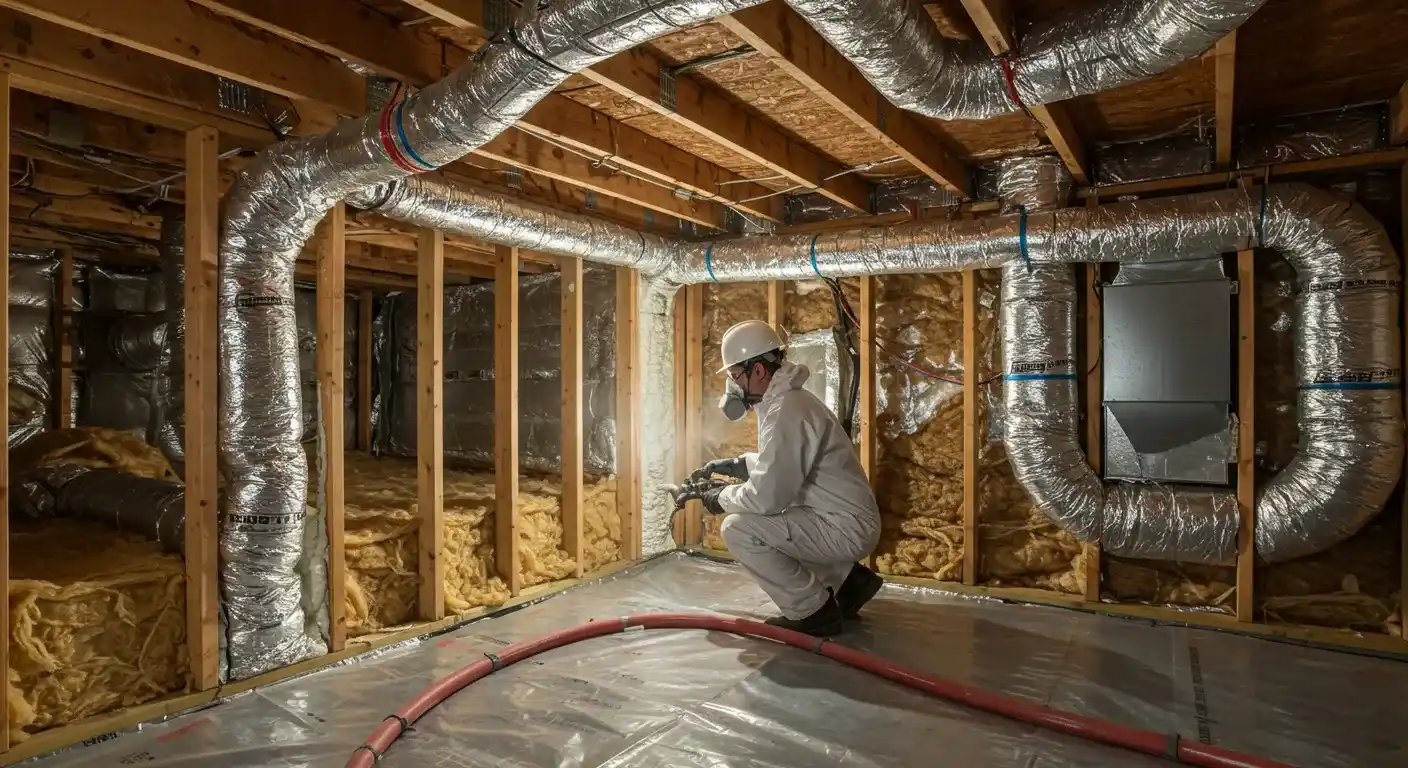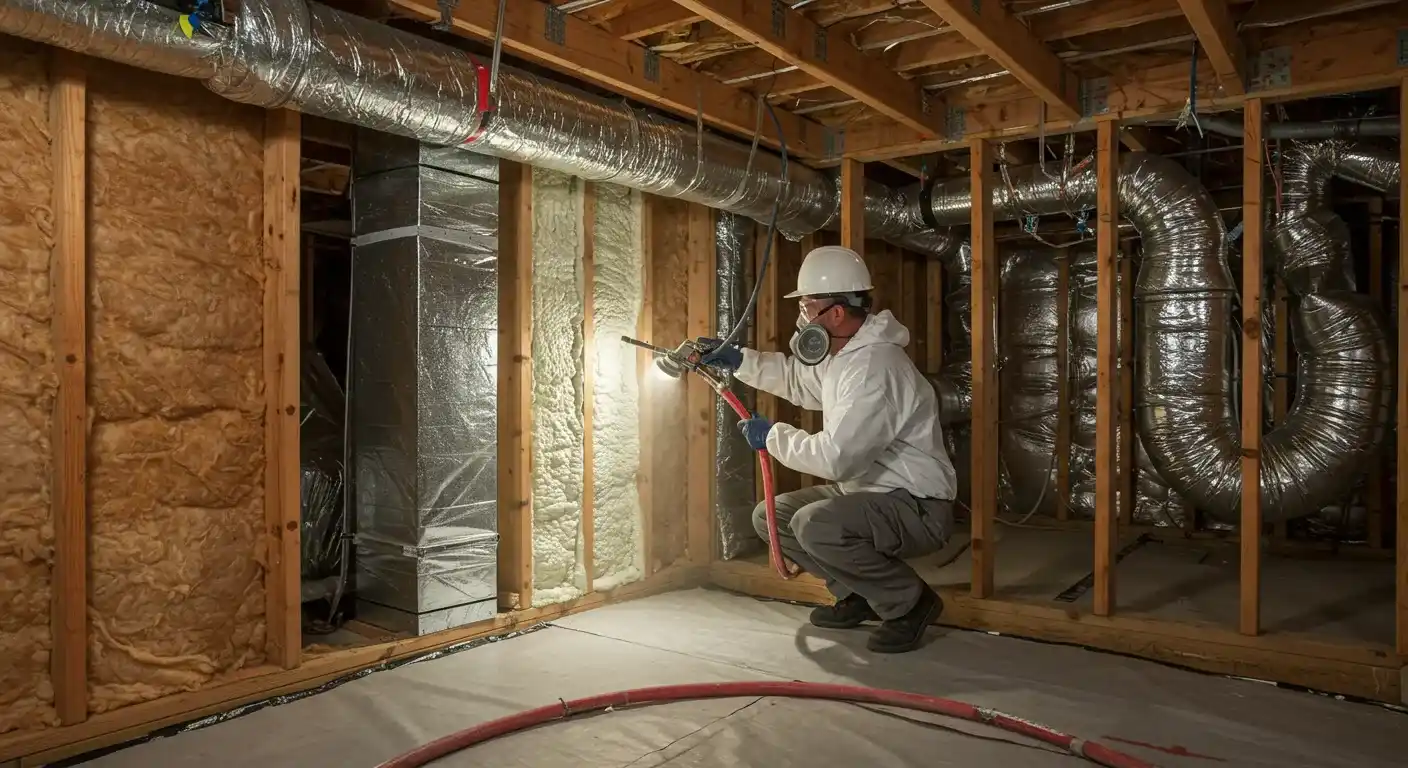Crawl Space Insulation Bell Canyon, CA
Serving Ventura County & Sacramento

Crawl Space Insulation Bell Canyon, CA
An insulated, well-sealed crawl space is one of the highest-impact improvements you can make for a Bell Canyon home. Proper crawl space insulation reduces energy bills, prevents moisture and mold, stabilizes floor temperatures, and protects ducting and plumbing that often run through that under-floor cavity. In Bell Canyon where mild Mediterranean weather mixes with seasonal marine layer humidity, controlling moisture and unwanted air exchange under the house is especially important to preserve indoor comfort and indoor air quality.
Types of crawl space insulation and where they go
Understanding the two primary locations for crawl space insulation helps you choose the right approach for your home: insulating the crawl-space floor (under the joists) vs insulating the crawl-space walls and conditioning the space.
- Crawl-space-floor insulation (under the subfloor between joists)
- Typical in vented crawl spaces. Common materials include fiberglass batts, mineral wool, or spray foam placed between joists.
- Best when the crawl space is intended to remain vented and unconditioned but you want to reduce heat transfer into the house above.
- Rim-joist insulation (around the perimeter where the floor meets the foundation)
- Critical for stopping major air leaks and thermal bridging. Materials commonly used are closed-cell spray foam, high-density rigid foam board, or canned spray foam for small gaps.
- Rim-joist work should be performed on virtually every home since this area is a frequent source of drafts and energy loss.
- Crawl-space-wall insulation and encapsulation (conditioning the crawl space)
- Modern best practice in many California homes: seal vents, install a continuous vapor barrier on the floor and up the walls, and insulate the foundation walls with rigid foam or spray foam. This creates a dry, semi-conditioned space that protects HVAC components and improves whole-house performance.

Recommended materials and typical R-value guidance
Material selection depends on the chosen strategy, existing moisture conditions, and access:
Closed-cell spray foam
- R-value: approximately R-6 to R-7 per inch.
- Pros: excellent air sealing and moisture resistance, ideal for rim-joists and foundation walls. Good for irregular shapes and sealing penetrations.
- Cons: higher cost but often the best long-term value where air sealing is a priority.
Rigid foam board (polyiso, XPS, EPS)
- R-values: polyiso ~R-6 to R-6.5 per inch; XPS ~R-5 per inch; EPS ~R-4 per inch.
- Pros: stable thermal performance on foundation walls and can pair with mechanical fasteners and tape.
- Cons: needs careful sealing at seams to perform well.
Fiberglass or mineral wool batts
- R-values: commonly R-13 to R-19 for standard joist depths.
- Pros: economical and common for floor cavities.
- Cons: susceptible to moisture and compression; not recommended where dampness or pests are present.
Vapor barriers and encapsulation materials
- Heavy-duty polyethylene or reinforced liners (12 to 20 mil commonly used) sealed to walls and piers, with taped seams and mechanical fastening. Quality vapor barriers are essential when choosing either floor insulation or wall insulation strategies.
Typical R-value ranges by application in Bell Canyon context:
- Rim-joist: aim for the equivalent of R-5 to R-15 depending on material and budget; closed-cell spray foam often achieves best results in limited thickness.
- Crawl-space floor (joist cavities): R-13 to R-19 is common depending on joist depth—deeper joists can accept higher R-values.
- Foundation walls (encapsulated/conditioned crawl space): R-5 per inch and up with rigid foam or spray foam applied continuous to the wall.
Installation process - what to expect
A professional insulation upgrade follows a clear process to protect your structure and ensure performance:
Inspection and moisture assessment
- Check for standing water, drainage issues, plumbing leaks, pest damage, and current ventilation. Moisture testing guides the right approach.
Repair and remediation as needed
- Fix plumbing leaks, adjust exterior grading or guttering if needed, and remediate pest or rot damage before insulating.
Air sealing and rim-joist treatment
- Seal utility penetrations, gaps, and the rim-joist. Use spray foam or rigid board to stop air leaks that drive energy loss.
Vapor barrier installation
- Lay continuous vapor barrier across the crawl-space floor, taped and sealed to the foundation walls and piers. Up the walls to create a sealed envelope if encapsulating.
- Insulation placement
- Install chosen insulation: batts pinned between joists, rigid foam or spray foam on walls, and ensure proper fit around ducts and plumbing.
Mechanical considerations and ventilation
- Decide between vented vs encapsulated strategy. Encapsulated spaces may require a dehumidifier or conditioned air source to manage moisture. Vented crawl spaces require properly sized vents and vapor barriers on the ground. Ducts in crawl spaces should be insulated and sealed.
Final inspection and performance checks
- Verify moisture levels, insulation coverage, and air sealing. Confirm ducts and equipment are protected.
Moisture control and ventilation considerations
In Bell Canyon, seasonal humidity and the local microclimate mean moisture control is not optional. Two modern approaches exist:
- Vented, unconditioned crawl space with floor insulation
- Relies on outdoor ventilation to remove moisture. This approach can work in dry climates but is less reliable where coastal humidity or trapped moisture occur.
- Encapsulated, conditioned crawl space with wall insulation
- Seals the space, installs a vapor barrier, and often adds mechanical dehumidification or ties the space into the home HVAC. This approach provides the best control of humidity, reduces mold risk, and protects ducts and equipment.
Choose encapsulation when evidence of moisture, mold, or high humidity is present. If you keep HVAC ducts or mechanical equipment in the crawl space, conditioning and insulating the walls often delivers the best return.
Benefits you can expect
- Lower energy bills and reduced HVAC runtime as floors transfer less heat and cold.
- Fewer musty smells and reduced mold and mildew risk with improved moisture control.
- More consistent floor temperatures and increased occupant comfort.
- Extended life and improved efficiency of HVAC ducting and plumbing located in the crawl space.
- Reduced pest intrusion when barriers and seals are properly installed.
Final notes on value and longevity
Properly selected materials and a thorough installation strategy tailored to Bell Canyon conditions make crawl space insulation an investment that pays back in comfort, energy savings, and reduced maintenance. Prioritize a full moisture assessment, quality vapor barrier, and air-sealing at the rim-joist for the best long-term performance.
More HVAC & PlumbingPlumbing Tips & Articles
.jpg) Ventilation& Air Purifiersdiscover more about it
Ventilation& Air Purifiersdiscover more about it.jpg) Ventilation& Air Purifiersdiscover more about it
Ventilation& Air Purifiersdiscover more about it.jpg) Ventilation& Air Purifiersdiscover more about it
Ventilation& Air Purifiersdiscover more about it


